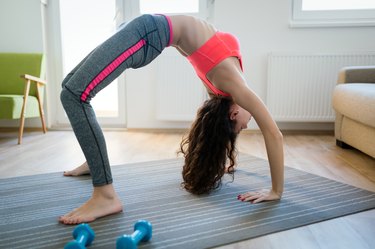
Whether as a child in gym class or as an adult in yoga, chances are you've heard of the hip bridge exercise.
Although the bridge is an effective glute-toning exercise, it also works the rest of your core, which includes your rectus abdominus, erector spinae, hamstrings and adductors. More advanced bridge exercise variations spread the workload a little more by working your hip flexors, quads and obliques.
Video of the Day
Video of the Day
Read more: How to Do Glute Exercises in Bed
Basic Technique for Hip Bridges
To perform basic hip bridges, lie flat on your back with your knees bent, feet flat on the floor. Think of pressing both feet into the floor as you squeeze your glutes, raising your hips until your body is in a straight line from shoulders to knees.
For more advanced variations on this exercise, you can extend one leg straight so it's in line with your body in the up position, or do glute bridges with both legs straight, resting on top of a stability ball.
Glutes and Thigh Stabilizers
Your gluteus maximus, with its powerful hip extension, is the primary mover for the hip bridges exercise — thus the much-vaunted butt-toning benefits. Your hamstrings also assist somewhat both for extending your hip and stabilizing your body, especially if you're performing the single-leg or stability-ball variations.
Note that your gluteus maximus isn't the only muscle on the back of your hip. Your gluteus medius and gluteus minimus, both of which lie deep in the gluteus maximus, also fire to help stabilize your hip throughout the bridge exercise. Your hip adductors, large muscles that run down the inside of each thigh, also work to keep you stable.
Read more: The Top 15 Moves to Tone Your Glutes
Consider Your Core
Glute bridges are an excellent core training exercise because they engage your rectus abdominus and erector spinae, which stabilize your spine against extension and flexion, respectively. Your rectus abdominus, in particular, works in an isometric contraction to help keep your pelvis from tilting too far forward, as if your belly button were reaching for your knees.
Try bridge exercise variations to target a wider range of muscles. Your obliques are also involved during bridges, acting most powerfully when you do a single-leg or stability-ball variation.
Leg-Extended Variation
During a single-leg bridge variation, your hip flexors and knee extensors also work, including the iliopsoas, sartorius and quadriceps. Your hip adductors, including the pectineus, adductor longus and adductor brevis, are also particularly active during this variation.
Your core muscles also need to work in over-drive to keep your pelvis from dropping to the side as you lift your leg.
Muscles Not Worked
Your shoulders remain on the ground throughout the glute bridge exercise, and you can extend both arms out to your side for extra stability — the wider you spread your arms, the more stable your body will be. But at no point should you try to push yourself up with your shoulder and arm muscles; all the effort of this exercise is focused from the ribs down.
Was this article helpful?
150 Characters Max
0/150
Thank you for sharing!
Thank you for your feedback!